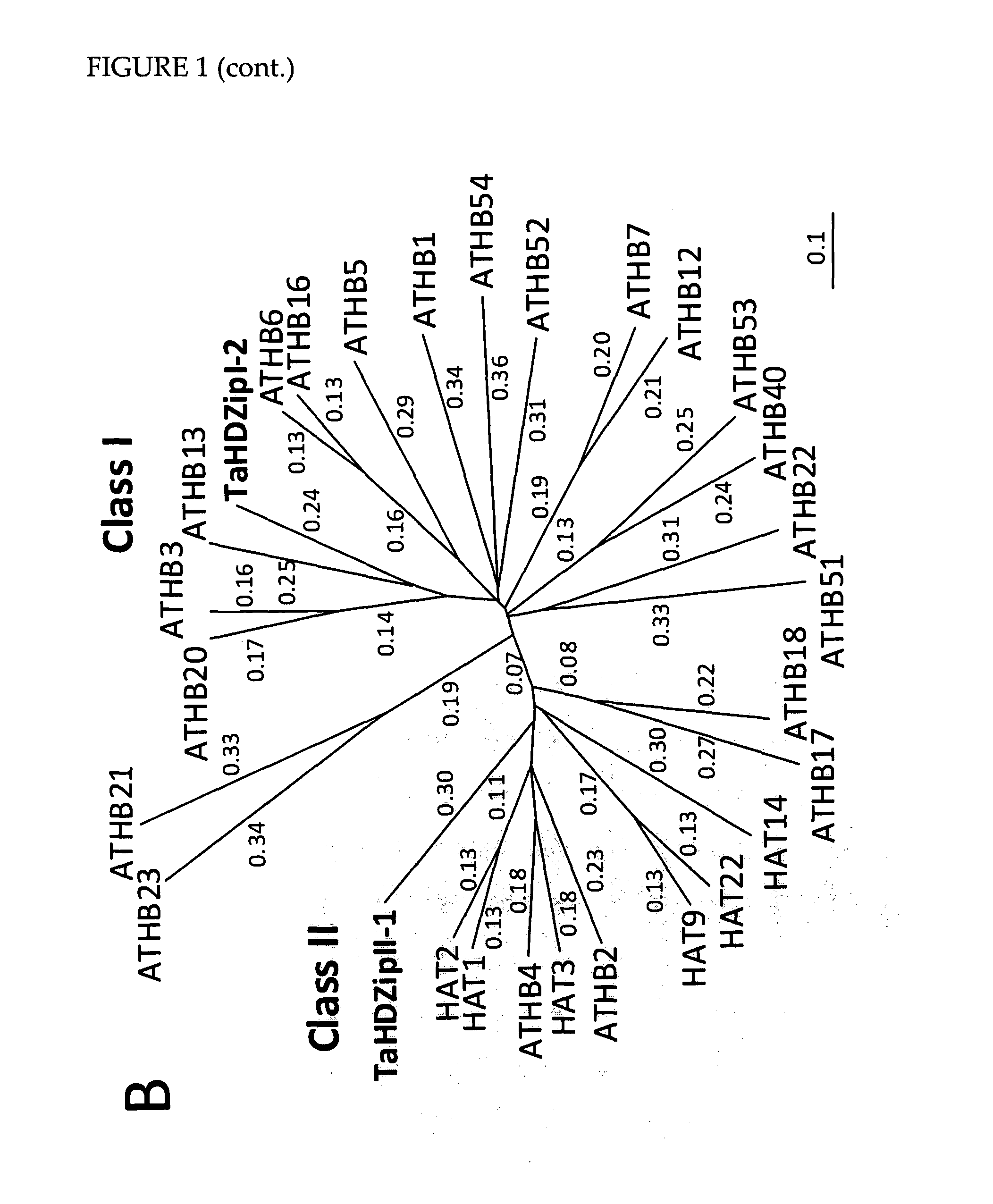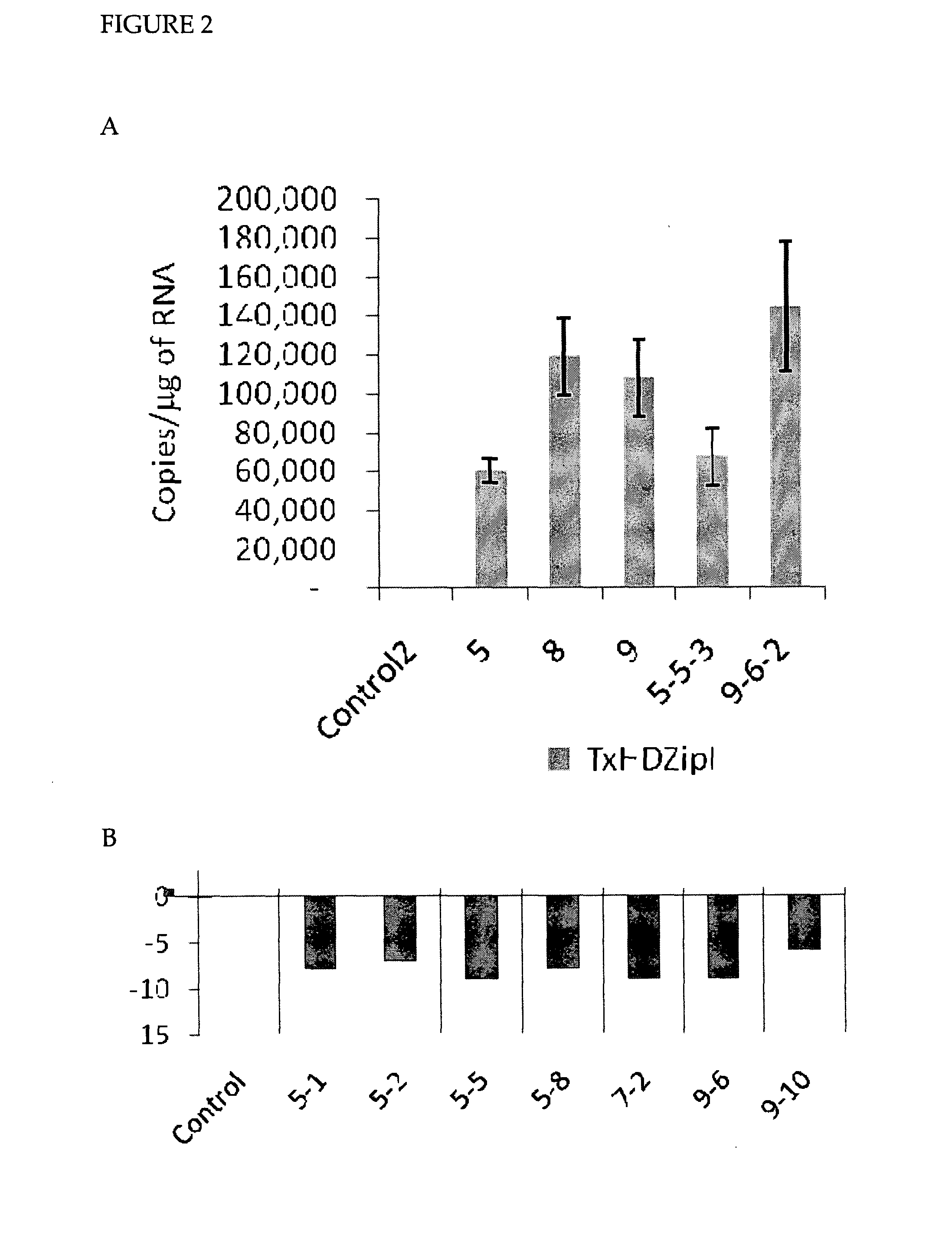Modulation of plant cell wall deposition via hdzipi
a plant cell wall and hdzipi technology, applied in foreign genetic material cells, plant cells, angiosperms/flowering plants, etc., can solve the problems of incomplete information about signal transduction and transcriptional regulatory proteins, which either activate or inhibit the biosynthesis of secondary cell walls, and achieve increased or relatively high increased or relatively low expression of an hdzipi polypeptide, and the effect of increasing the rate and/or extent of cell wall
- Summary
- Abstract
- Description
- Claims
- Application Information
AI Technical Summary
Benefits of technology
Problems solved by technology
Method used
Image
Examples
example 1
Isolation of Wheat TaHDZipI-2
[0172]TaHDZipI-2 cDNA clones were isolated from a cDNA library made from the liquid fraction of wheat endosperm at 3-6 DAP (days after pollination). The clones were identified from a yeast one hybrid screen using a 4× repeat of the nucleotide sequence CAATNATTG as bait (Lopato et al., Plant Methods 2: 3, 2006). Originally each repeat in the bait contained a different nucleotide in the N position. However, it has been demonstrated in Arabidopsis that these classes of transcription factors will bind to the bait sequence irrespective of the base in the central position. Wheat HDZip proteins appear to interact well with the CAATCATTG repeats in the Y1H assay and can be isolated using this repeat.
[0173]The cloned cDNA was designated and TaHDZipI-2 (SEQ ID NO: 2). Based on a sequence comparison of the encoded amino acid sequence (SEQ ID NO: 1) to HDZip class I and II proteins from rice and Arabidopsis (FIG. 1), TaHDZipI-2 was found to cluster with class I HDZi...
example 2
Expression of TaHDZipI-2 in Wheat
[0174]Transcripts of TnHDZipI-2 were detected by Q-PCR in flowers, early grain and shoots of seedlings, but were very low in roots of seedlings and young inflorescence. No expression was found in leaves or stems of mature plants.
example 3
Phenotype from Over-Expression of TaHDZipI-2 in Barley
[0175]Barley (Hordeum vulgare cv. Golden Promise) was transformed with TaHDZipI-2 in a modified of pMDC32 vector, in which 2×35S promoter was replaced with the polyubiquitin promoter from maize. The pUbi vector containing the coding region of TaHDZipI-2 (SEQ ID NO: 2) under the transcriptional control of the polyubiquitin promoter was designated pUbi-TaHDZipI-2.
[0176]Plants which were successfully transformed with pUbi-TaHDZipI-2, and which subsequently overexpress HDZipI-2, are referred to herein as “HDZipI plants”.
[0177]10 independent transgenic lines were produced with HDZipI, all showing expression of the transgene (See FIG. 2). The copy number, level of transgene expression and relative strength of phenotype in T0 plants is summarized in Table 2, below:
TABLE 2Transgene incorporation in HDZipI plantsStrength ofName of the T0Transgene copytransgeneStrength oftransgenic linenumberexpressionphenotypeG109-1No data+++G109-2No data...
PUM
 Login to View More
Login to View More Abstract
Description
Claims
Application Information
 Login to View More
Login to View More - R&D
- Intellectual Property
- Life Sciences
- Materials
- Tech Scout
- Unparalleled Data Quality
- Higher Quality Content
- 60% Fewer Hallucinations
Browse by: Latest US Patents, China's latest patents, Technical Efficacy Thesaurus, Application Domain, Technology Topic, Popular Technical Reports.
© 2025 PatSnap. All rights reserved.Legal|Privacy policy|Modern Slavery Act Transparency Statement|Sitemap|About US| Contact US: help@patsnap.com



